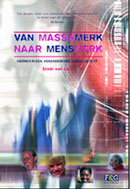Brands grew up in the era of mass communication. As the media context now changes, brands are changing too. The biggest brands of the next century are not as good at shouting hard: instead, they can especially listen very well. Coaching brands develop, which provide ready-to-use information, products and services to the individual consumers. Coaching brand agents are the intelligent software representatives of these brands. These agents are visible on every possible display and they look like living creatures, and in the long term even like human beings. With these agents, consumers start a spoken, personal dialogue. These brands become friends who are always available, anywhere in the world. In this mature media context, the consumer finally gets a real relationship with brands.
The changing media context more and more forces brands to openness. The internal brand culture becomes more visible: brands experience a brand coming out. Brands are forced to work on themselves. These brands-new-style unite people instead of products. They will be as important for people as religion used to be in the past. With this, the visual surroundings evolve from company logos to 3D worlds full of sounds and symbols.
We have a vision of new-style brands in 2015. But what does this vision mean for today’s business? Changes seldom occur through revolution, they always start with small steps. We can take those small steps today. How can a brand manager adapt today’s strategy to tomorrow’s developments? What should a marketer do? What opportunities do the broadcasting networks have? And media, design, or advertising agencies? This book contains extensive practical tips for professionals in all different roles, giving direction for tomorrow.
Dutch marketing gurus Giep Franzen and Rik Riezebos wrote a preface for the book. This was the first book in the Netherlands with an accompanying web log. Almost instantly after publication, the book was nominated for the Dutch Marketing Literature Award of the year.
 My book ‘Van Massamerk naar Mensmerk’ (From Mass Brand to Personal Brand, Dutch) describes how our media context will change over the coming ten years, how marketing and brands will adapt to this, and how today’s professionals can anticipate. Every day we work on making the world a better place, on a worldwide basis. Every day the future gets one small step closer. As we can take these small steps ourselves today, I closely follow the evolution of media, marketing and brands in the tab
My book ‘Van Massamerk naar Mensmerk’ (From Mass Brand to Personal Brand, Dutch) describes how our media context will change over the coming ten years, how marketing and brands will adapt to this, and how today’s professionals can anticipate. Every day we work on making the world a better place, on a worldwide basis. Every day the future gets one small step closer. As we can take these small steps ourselves today, I closely follow the evolution of media, marketing and brands in the tab  In 2005 my book ‘Van Massamerk naar Mensmerk’ (From Mass Brand to Personal Brand, Dutch) received a top-3 nomination for the Dutch Marketing Literature Award of the year. This prize is presented by the Dutch Platform for Innovation in Marketing (
In 2005 my book ‘Van Massamerk naar Mensmerk’ (From Mass Brand to Personal Brand, Dutch) received a top-3 nomination for the Dutch Marketing Literature Award of the year. This prize is presented by the Dutch Platform for Innovation in Marketing (